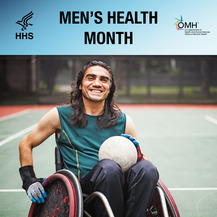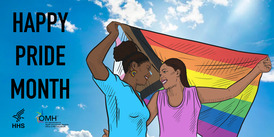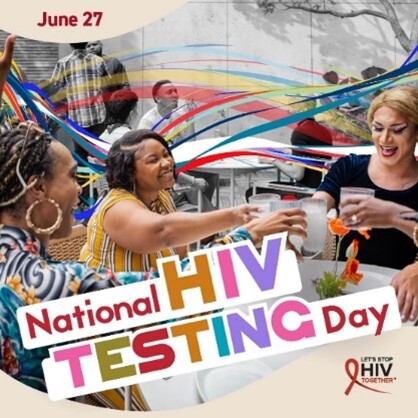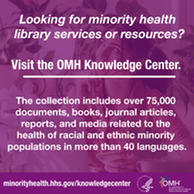
June is Men’s Health Month!
This annual observance encourages men and boys to be proactive in their health by implementing healthy living decisions.
The U.S. Department of Health and Human Services (HHS) Office of Minority Health (OMH) is committed to working with public health and community-based partners to Be the Source for Better Health by providing racial and ethnic minority and American Indian/Alaska Native (AI/AN) men quality, equitable, and respectful care and services that are responsive to diverse cultural health beliefs and practices, preferred languages, economic and environmental circumstances, and health literacy levels.
On average, men in the United States die nearly 6 years earlier than women and are at higher risk for many serious diseases, including heart disease, lung cancer, and HIV. In addition, men experience unique health problems that don’t affect women, like prostate cancer. Negative impacts of social determinants of health (SDOH), like economic stability and educational access and quality, can increase their risk for poor health outcomes.
Together we can help racial and ethnic minority and AI/AN boys and men make informed health decisions and decrease the incidence of preventable disease by understanding how their unique environments, cultures, histories, and circumstances impact their overall health.
Visit the OMH Men’s Health Month 2024 website to find resources, social media messages, graphics, and information on how to Be the Source for Better Health for the men in your life.
Men’s Health Week (June 10 – 16) and Wear BLUE Day (June 14)
Men's Health Week takes place June 10 – 16 and aims to provide access to the information, services, and treatment men and boys need to live healthier, longer, and more fulfilling lives. On June 14, the Friday of Men’s Health Week, join Men’s Health Network in celebrating Wear BLUE Day to raise awareness about male health and encourage men to live longer and healthier lives.
In honor of Men’s Health Month, from June 24 – 28 OMH will conduct a week-long Q & A session with federal partners on our Instagram Stories to focused on efforts and resources addressing the wellbeing of racial and ethnic minority and AI/AN men. Join the event by following OMH on Instagram.
|

June is LGBTQI+ Pride Month, an observance that celebrates the LGBTQI+ community and the fight for equal rights. This month, join HHS and OMH in advancing health equity for LGBTQI+ people and families, preventing discrimination against LGBTQI+ people, and working to close the LGBTQI+ health disparities gap.
According to the Centers for Disease Control and Prevention (CDC), compared to their heterosexual peers, lesbian, gay, and bisexual (LGB) adolescents are more likely to be bullied at school, feel sad or hopeless, and seriously consider suicide. In 2021, about 25% of students who identified as LGB reported being bullied in school. Of that, 22.9% were Hispanic students, 18.9% were multiracial students, 16.8% were Asian students, and 14.5% were Black students. Male students who identified as LGB reported being bullied more than their female counterparts (26.7% vs. 23.7% respectively).
Nearly 1 million people in the United States identify as transgender and experience numerous health disparities as well as stigma, discrimination, and lack of access to quality gender-affirming care. Some health disparities include mental health disparities and an increased risk of HIV infection, especially among transgender racial and ethnic minority women. Most new HIV cases among transgender people in 2019 were among African American transgender women (46%) and Hispanic transgender women (35%). Transgender adults are also more likely to be uninsured than cisgender adults and are more likely to report postponement of health care utilization due to fear of discrimination.
HHS is committed to working to ensure that LGBTQI+ people, their families, and communities receive equal access to health services by providing enhanced resources for LGBTQI+ health issues and developing better information regarding LGBTQI+ health needs.
Visit the HHS LGBTQI+ Health & Well-being webpage for the latest news, reports, and health resources for LGBTQI+ people.
|

The 4th annual National Black Family Cancer Awareness Week (NBFCAW) takes place June 13 – 19 this year and is led by the U.S. Food and Drug Administration (FDA) Oncology Center of Excellence. This initiative, established in 2021, aims to prevent unnecessary cancer burden on Black families by raising cancer awareness, encouraging understanding of family cancer history, and promoting cancer clinical trial participation and specimen donation.
According to the CDC, compared to members of other racial and ethnic groups, non-Hispanic Black people are at an increased risk of getting and dying from many kinds of cancer. In 2022, non-Hispanic Black Americans had the highest mortality rates of any racial and ethnic group for all cancers combined and the second highest rate of new cancer diagnoses.
By being aware of family risk factors, practicing healthy prevention behaviors as a family, and following recommended cancer screening measures we can help prevent cancer in Black Americans.
Visit the NBFCAW webpage for more information, ways to engage, events, videos, and customizable graphics, and be sure to join the conversation using the hashtag #BlackFamCan.
|

June 19 is World Sickle Cell Day, an international awareness day that aims to increase public knowledge and understanding of sickle cell disease and the challenges experienced by patients, their families, and caregivers.
This year the Shine the Light on Sickle Cell campaign, supported by the Health Resources and Services Administration (HRSA), invites everyone to raise awareness of this serious public health concern affecting more than 100,000 people in the United States and 20 million people around the world.
In the United States, most people who have sickle cell disease are of African ancestry or identify themselves as Black. About 1 in 13 Black or African American babies are born with sickle cell trait and about 1 in every 365 Black or African American babies are born with sickle cell disease. A cross-sectional analysis done by CDC found that from 2016–2020 among 3,305 newborns with confirmed sickle cell disease (SCD), 90% were Black or African American.
HHS is proud to work alongside federal partners and agencies as well as partners and leaders outside of government to improve data quality and collaboration to better tackle this complex disease. In December 2023, the FDA approved two new therapies to treat sickle cell disease. Read the press release on the First Gene Therapies to Treat Patients with Sickle Cell Disease.
Visit the Shine the Light webpage to find events celebrating World Sickle Cell Day and download and share resources as you prepare to Shine the Light!
Juneteenth (June 19)
June 19 is Juneteenth National Independence Day, an annual holiday commemorating the final enforcement of the Emancipation Proclamation in the state of Texas on June 19, 1865, in the last days of the U.S. Civil War. Though widely celebrated in many communities dating back to 1866, Juneteenth was officially declared a federal holiday in 2021. Also known as “Freedom Day,” Juneteenth reminds us that the struggle for equity for Black and African Americans continues and calls on us to reflect on how to build a country where all people are truly equal and have access to life, liberty, and good health.
|

National HIV Testing Day (NHTD) is observed each year on June 27 to highlight the importance of HIV testing and knowing your status so you can choose options to stay healthy. This year’s theme, Level up your self-love: check your status, emphasizes valuing yourself, showing yourself compassion and respect, and honoring your health needs with self-love.
HIV.gov reports that approximately 1.2 million people in the United States have HIV, and about 13% of them don’t know it and need testing. Additionally, in 2021, Black/African American people represented 12% of the U.S. population, but accounted for 40% of new HIV cases. Similarly, Hispanic/Latino people represented 18% of the U.S. population, but 26% of people with HIV.
Today, there are more free, easy, fast, and confidential HIV testing options available than ever before. Testing, including self-testing, is the first step to engaging in HIV prevention and treatment services. People who receive a negative test result can take advantage of HIV prevention tools such as pre-exposure prophylaxis (PrEP) and condoms. People who receive a positive test result can rapidly start HIV treatment to stay healthy.
Use the hashtag #HIVTestingDay and social media messages from the CDC to promote NHTD and tell your networks about the many options for getting tested for HIV. HIV testing is a critical tool to help us end the HIV epidemic in the United States.
For more information and resources on HIV testing, visit the CDC Let’s Stop HIV Together webpage.
|

In honor of Men’s Health Month and Pride Month, the OMH Knowledge Center is featuring a collection of resources related to the health of sexual and gender minority (SGM) men from racial and ethnic minority communities. Topics include PrEP awareness and uptake, challenges related to social stigma, mpox vaccination efforts, and more. Many of these resources are available online for free.
You can access this collection through the OMH Knowledge Center online catalog.
|
|